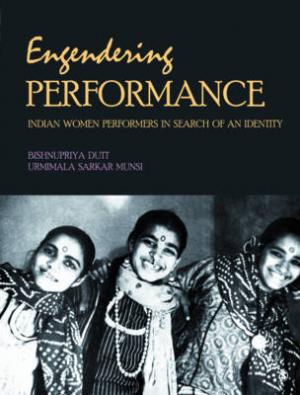Engendering Performance: Indian Women Performers in Search of an Identity

In its very fragmentariness, Engendering Performance: Indian Women Performers in Search of an Identity serves as an alternative to the traditional scholarly textbook. Engendering Performance seems best utilized as a jumping off point for conversations, further studies and exchanges of the kind found in classrooms of higher education. The authors have purposefully refrained from offering an all encompassing meta narrative in exploring the role and position of gender and women in defining identity through theatre and dance.
In their introduction, the authors note that the concept for the book was developed as they designed a curriculum for the study of the performing arts for The School of Arts and Aesthetics at Jawaharlal Nehru University, Delhi in 2000. The book was born out of a desire to take a critical look at identity and body politics, dipping into a plethora of fields, including history, economics, cultural studies, ethnography, and feminist criticism to pose questions regarding the role of the actress-dancer in colonial and national culture as well as to analyze performance. The book aims to examine the meanings of performative gestures, as well as aesthetic historical codes, in other words, to debunk what history has taught and written with regard to theatre and dance, keeping gender in mind. The authors aim to simultaneously exist outside of prescribed disciplines, while interacting with them. In doing so, Engendering Performance reclaims the voice of the actress, moving against the general concept that the male actor is the voice and the actress is left at the margins.
While I do not come from a background of scholarly writings on theatre and dance, and I may have been lost at certain points when it came to the various topics and theatre- and dance-specific jargon, overall I found the text to be a worthwhile introduction to some of the continual questions and issues that arise within a new field, or a series of interrelated subjects. The book is divided into two sections, the first focusing on “The Story of the Actress” and the second entitled “Of The Woman Dancer.” Each chapter is a different look at aspects of these professions and identities.
The first chapter begins with an examination of the structures and spaces of theatres, while the second chapter discusses the challenge of public and private lives especially in the duality and the roles the actress must play.The authors discuss the custom of prostitutes as actresses, among other issues of space and identity. One chapter also looks at the Indian People’s Theatre Association (IPTA) which was initially formed as the cultural branch of the Communist Party, bringing theatre into politics while expanding the role and scope of the actress’ identity. Section two focuses primarily on dance and begins with a critical look at the ancient text of Natya Sastra, called the 5th Veda and seen as a performer’s rule-book. The authors pose questions such as “Who benefits from Natyasastra being the rule-book of gender and class/caste behaviour?” The following chapter takes a closer look at the body and the growing role of the body as a tool for a woman to “speak and write and communicate her-story as opposed to the common history.” In the last chapter, “Tale of Professional Woman Dancer in Folk Traditions in India: Commodification of Dance and the Traditional Dancing Women,” the text looks at the distinct rural and urban identities and the many levels of marginalization.
The final conclusion, instead of serving as a comprehensive overview, is a discussion with Samik Bandyopadhyay, a Kolkata-based critic of art, theatre and film.The intention of “disturbing the dominant narrative” seems to have been achieved, albeit in a fragmented way, which is acknowledged in the final discussion. Bandyopadhyay acknowledges the limitations of such a text; he says, and I agree, that this is an ongoing process. Connecting practice to theory and transcending fixed categories or genres, Engendering Performance takes a step and moves those seeming to encroach on this space, in order to create a new genre of performance studies based on the varied experiences within India.